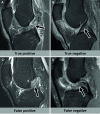Artificial intelligence for MRI diagnosis of joints: a scoping review of the current state-of-the-art of deep learning-based approaches
- PMID: 34467424
- PMCID: PMC8692303
- DOI: 10.1007/s00256-021-03830-8
Artificial intelligence for MRI diagnosis of joints: a scoping review of the current state-of-the-art of deep learning-based approaches
Abstract
Deep learning-based MRI diagnosis of internal joint derangement is an emerging field of artificial intelligence, which offers many exciting possibilities for musculoskeletal radiology. A variety of investigational deep learning algorithms have been developed to detect anterior cruciate ligament tears, meniscus tears, and rotator cuff disorders. Additional deep learning-based MRI algorithms have been investigated to detect Achilles tendon tears, recurrence prediction of musculoskeletal neoplasms, and complex segmentation of nerves, bones, and muscles. Proof-of-concept studies suggest that deep learning algorithms may achieve similar diagnostic performances when compared to human readers in meta-analyses; however, musculoskeletal radiologists outperformed most deep learning algorithms in studies including a direct comparison. Earlier investigations and developments of deep learning algorithms focused on the binary classification of the presence or absence of an abnormality, whereas more advanced deep learning algorithms start to include features for characterization and severity grading. While many studies have focused on comparing deep learning algorithms against human readers, there is a paucity of data on the performance differences of radiologists interpreting musculoskeletal MRI studies without and with artificial intelligence support. Similarly, studies demonstrating the generalizability and clinical applicability of deep learning algorithms using realistic clinical settings with workflow-integrated deep learning algorithms are sparse. Contingent upon future studies showing the clinical utility of deep learning algorithms, artificial intelligence may eventually translate into clinical practice to assist detection and characterization of various conditions on musculoskeletal MRI exams.
Keywords: Artificial intelligence; Computer; Deep learning; Joints; Magnetic resonance imaging; Musculoskeletal system; Neural networks.
© 2021. The Author(s).
Conflict of interest statement
Benjamin Fritz: none. Jan Fritz: Jan Fritz received institutional research support from Siemens AG, BTG International, Zimmer Biomed, DePuy Synthes, QED, and SyntheticMR; is a scientific advisor for Siemens AG, SyntheticMR, GE Healthcare, QED, BTG, ImageBiopsy Lab, Boston Scientific, and Mirata Pharma; and has shared patents with Siemens Healthcare and Johns Hopkins University.
Figures







Similar articles
-
Radiomics and Deep Learning for Disease Detection in Musculoskeletal Radiology: An Overview of Novel MRI- and CT-Based Approaches.Invest Radiol. 2023 Jan 1;58(1):3-13. doi: 10.1097/RLI.0000000000000907. Epub 2022 Sep 1. Invest Radiol. 2023. PMID: 36070548
-
Deep-learning-assisted diagnosis for knee magnetic resonance imaging: Development and retrospective validation of MRNet.PLoS Med. 2018 Nov 27;15(11):e1002699. doi: 10.1371/journal.pmed.1002699. eCollection 2018 Nov. PLoS Med. 2018. PMID: 30481176 Free PMC article.
-
Application of artificial intelligence to imaging interpretations in the musculoskeletal area: Where are we? Where are we going?Joint Bone Spine. 2023 Jan;90(1):105493. doi: 10.1016/j.jbspin.2022.105493. Epub 2022 Nov 21. Joint Bone Spine. 2023. PMID: 36423783 Review.
-
Medical Imaging Applications Developed Using Artificial Intelligence Demonstrate High Internal Validity Yet Are Limited in Scope and Lack External Validation.Arthroscopy. 2025 Feb;41(2):455-472. doi: 10.1016/j.arthro.2024.01.043. Epub 2024 Feb 5. Arthroscopy. 2025. PMID: 38325497 Review.
-
A Deep Learning System for Synthetic Knee Magnetic Resonance Imaging: Is Artificial Intelligence-Based Fat-Suppressed Imaging Feasible?Invest Radiol. 2021 Jun 1;56(6):357-368. doi: 10.1097/RLI.0000000000000751. Invest Radiol. 2021. PMID: 33350717 Free PMC article.
Cited by
-
Deep learning-based classification of erosion, synovitis and osteitis in hand MRI of patients with inflammatory arthritis.RMD Open. 2024 Jun 17;10(2):e004273. doi: 10.1136/rmdopen-2024-004273. RMD Open. 2024. PMID: 38886001 Free PMC article.
-
MRI deep learning models for assisted diagnosis of knee pathologies: a systematic review.Eur Radiol. 2025 May;35(5):2457-2469. doi: 10.1007/s00330-024-11105-8. Epub 2024 Oct 18. Eur Radiol. 2025. PMID: 39422725 Free PMC article.
-
AI applications in musculoskeletal imaging: a narrative review.Eur Radiol Exp. 2024 Feb 15;8(1):22. doi: 10.1186/s41747-024-00422-8. Eur Radiol Exp. 2024. PMID: 38355767 Free PMC article. Review.
-
2D versus 3D MRI of osteoarthritis in clinical practice and research.Skeletal Radiol. 2023 Nov;52(11):2211-2224. doi: 10.1007/s00256-023-04309-4. Epub 2023 Mar 13. Skeletal Radiol. 2023. PMID: 36907953 Review.
-
Multimodal AI in Biomedicine: Pioneering the Future of Biomaterials, Diagnostics, and Personalized Healthcare.Nanomaterials (Basel). 2025 Jun 10;15(12):895. doi: 10.3390/nano15120895. Nanomaterials (Basel). 2025. PMID: 40559258 Free PMC article. Review.
References
-
- Gore JC. Artificial intelligence in medical imaging. Magn Reson Imaging. 2020;68:A1–A4. - PubMed
-
- Lee CS, Nagy PG, Weaver SJ, Newman-Toker DE. Cognitive and system factors contributing to diagnostic errors in radiology. AJR Am J Roentgenol. 2013;201(3):611–617. - PubMed
-
- Germann C, Marbach G, Civardi F, Fucentese SF, Fritz J, Sutter R, et al. Deep convolutional neural network-based diagnosis of anterior cruciate ligament tears: performance comparison of homogenous versus heterogeneous knee MRI cohorts with different pulse sequence protocols and 1.5-T and 3-T magnetic field strengths. Invest Radiol. 2020; 55(8):499–506. - PMC - PubMed
-
- Fritz J, Germann, C., Sutter R, Fritz B. AI-augmented MRI diagnosis of ACL tears: which readers benefit? SSR Annual Meeting 2021.
Publication types
MeSH terms
LinkOut - more resources
Full Text Sources

